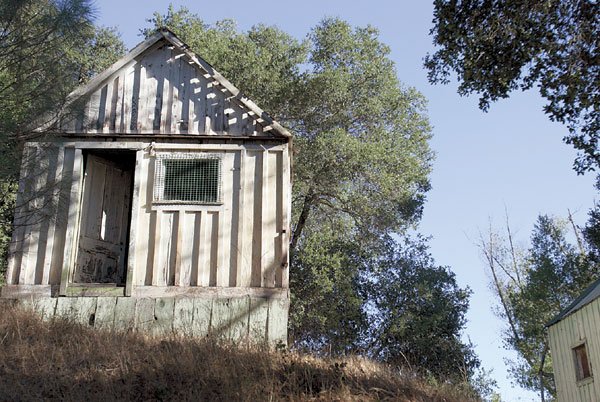Gilroy
– Even though he almost drowned at the vacation resort as a
toddler, Jack Sturla has fond memories of the Gilroy Hot
Springs.
As the 86-year-old retired Gilroy farmer recalls the 1921
incident
…
”
I was probably about two years old,
”
he said.
”
I was sitting on the end of the swimming pool, watching
everyone. Everyone was having a good time.
”
Gilroy – Even though he almost drowned at the vacation resort as a toddler, Jack Sturla has fond memories of the Gilroy Hot Springs.
As the 86-year-old retired Gilroy farmer recalls the 1921 incident … “I was probably about two years old,” he said. “I was sitting on the end of the swimming pool, watching everyone. Everyone was having a good time.”
Something happened – perhaps a wave generated by some swimmer hit the child – and he was suddenly under the water. Luckily, a woman quickly noticed and pulled him up, saving baby Sturla from possible disaster.
This Thursday, the Gilroy History Museum will open a special exhibit detailing the story of the former hot spring resort located in a scenic Diablo Range canyon 12 miles east of the city. Stories like Sturla’s will bring to life the hot springs in its hey day.
“It was a big tourist attraction,” said Lucy Solórzano, the museum coordinator. “People would come from San Francisco all the time. This was their summer vacation.”
Every so often in the 21st century, too, vacationing motorists passing through Gilroy along U.S. 101 see the hot springs historical site marker and decide to take the next exit – often with bathing suits and towels in hand.
“We get people from all over that say they saw the sign from the freeway,” said Teddy Goodrich who is scheduled to present a slide show about the springs at the museum Thursday night. With a laugh, she suggested that a “CLOSED TO PUBLIC” sign should be added to the freeway historical marker so innocent vacationers with high hopes of getting themselves into hot water aren’t lured to a big disappointment. The springs, which are part of Henry W. Coe State Park, can only be visited through a guided tour with a park ranger.
History of the springs
The waters feeding the springs are heated to about 107 degrees by the Madrone Springs fault. They were first discovered in 1865 by a sheepherder named Francisco Cantua, who turned it into a campground. Visitors came from all over California to soak in the waters, paying $2 a week for the privilege.
A year later, Cantua sold the site to William Oldham and George Roop who built a two-story, 60-foot-square hotel and several cottages to lure guests. The business proved lucrative, and they added a third-story in 1879. The burgeoning resort contained three dining rooms and could accommodate about 200 guests.
By the 1890s, Gilroy Hot Springs was the most fashionable place in California for San Francisco’s elite to “take the waters.” They hiked, rode horses, fished, played croquet, danced, enjoyed group sing-alongs and whiled away the lazy days. And, of course, they frequently soaked in and drank the spring water – which still smells like sulfurous rotten eggs.
The resort’s popularity started to fade in the late 1920s. By 1932 as the Great Depression cut into business. The property was sold in 1938 to Harry Sakata, a successful Watsonville farmer who opened it to local residents as a popular weekend getaway.
Sturla remembers those days at the hot springs vividly. He and his family would visit for picnics and hikes. As a teenager, he went several times on high school outings, immensely enjoying his time flirting with pretty girls.
“The girls and boys would splash around the pool,” he said. “Some fellows would put a girl on their shoulders in the water, and they’d try to push each other off.”
After WWII, the springs became a site for many reunions of Japanese-American families interned in concentration camps throughout the West Coast. The old hotel served for a few years in the late 1940s as a home for elderly Japanese. An attempt in the 1950s was made to revive the resort, but times had changed. People preferred to vacation elsewhere. Sakata kept the hot springs open for picnicking, swimming and horseback riding until 1964. That year, he sold the property to a consortium which used it for private recreation.
In May of 1980, the consortium put the property on the market, asking $1.5 million. On September 7 of that year, a fire burned the old redwood hotel to the ground.
Fukuyahama International of Japan purchased the land in 1988, hoping to rebuild it as a vacation resort to attract Japanese tourists. The Santa Clara County Planning Commission and the Board of Supervisors, however, vetoed the proposal because it might endanger the environment.
A few years later, San Francisco resident Masaru Seido bought the property and allowed residents to enjoy bathing in the waters.
In January 2002, Seido sold the historical 242-acre property to the Nature Conservancy of California. In July 2003, the site became part of Henry W. Coe State Park which bought it for $2.4 million.
The future
Recently, Goodrich and Coe Park Ranger Cameron Bowers took a tour of the site to take slides for Thursday’s presentation. The run-down former resort is occupied only by the ghostly memories of another age. The hotel’s location is now a parking area overgrown with weeds. The 20 or so remaining cabins slowly deteriorate as vandals break windows and graffiti walls. The hot tubs and swimming pools are filled in to prevent accidents. Bowers cupped his hand and drank a sip from the hot water gurgling out of the earth. That water, in a long-ago time, created a thriving resort for Gilroy.
Sturla scanned the decaying buildings. The place still has potential, he believes. California would like to make a deal with some concession business to revitalize the site, he said.
Sturla also sees potential for the hot springs to draw people once again. About four years ago, he and his friend Keith Soward (whose father once drove the stage from the depot to the resort) returned to the site and met some day-visitors immersed in the water .
“We talked to a fairly young couple who had driven a long ways from Santa Barbara,” Sturla recalls. “They had taken treatments at other hot spring with mineral water available. They said the best results they ever got were at the Gilroy Hot Springs.”
Although the retired farmer once almost drowned in that water, he still hopes the historic site will be preserved so that future visitors can once again “take the waters.”
“There’s a lot of memories there,” Sturla said fondly. “A lot of good memories… It was a great place to go.”
Exhibit grand opening
When: Thursday Oct. 7 at 6pm
Where: Gilroy History Museum at 195 Fifth St.
What: Wine and cheese reception followed by a presentation at around 6:30pm showing the history of the hot springs and how it looks now.
R.S.V.P. by 5pm, Oct. 4 by calling 848-0470
Museum hours
• Mon., Tues., Thur., Fri.: 10am to 5pm
• First Saturday of each month from 10am to 2pm
• Closed Sunday, holidays and most Saturdays
• Also open by appointment













